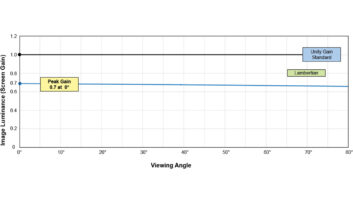
As a residential electronic systems contractor (RESC) you probably got into this business because you love the process and the results. Producing the best quality and most integrated system for your clients can put you on cloud nine. There are lots of aspects of your job (selling, installing, managing systems, and programming) that keep you in this business. But bookkeeping is not top on your list of priorities; for many of you, it’s not even on the list at all. It’s an odd fact that we only worry about cash flow when we don’t have any.
But managing an install business requires you to plan ahead and track the money in and money out. QuickBooks is the most-used software for small businesses as a whole and for this industry in particular. Many small businesses in this industry use QuickBooks because it is relatively inexpensive and easy to use. However, the ease of use also means ease of abuse. I work with several software packages and find that the more stringent ones can be more powerful and provide better information. However, they are more expensive and often require a better understanding of accounting to use effectively.
Therefore, given the wide acceptance of QuickBooks, understanding best practices for it can go a long way to helping your company in good times and in bad. And with everyone worrying about the slowing economy, it is even more important to improve the way you run the financial arm of your company. While QuickBooks training classes can be hours or days long and we cannot provide all the best practices in this short article, it is important to point out a few tips for the residential systems contractor.
Money in and Money Out
QuickBooks was created by Intuit from customer demand. Many individuals used Quicken for their personal finances and began using it for their small business. But Quicken is not an accounting package, and business owners demanded a better program that could be used in their small companies. Hence QuickBooks was developed and launched in April of 1992. In the last 15 years, this package has grown to include many different features and tools for the small business. What started out as a very simple program has become feature rich (a good thing) but at the expense of ease of use.
“Given the wide acceptance of QuickBooks, understanding best practices for it can go a long way to helping your company ingood times and in bad”
But QuickBooks still does what it does best: tracking money in and money out. Taking that one step further, you can invoice your customers to better account for the money in and enter bills from vendors to track the money out. This converts what used to be a cash-basis accounting system into an accrual-basis accounting system. Income is recognized when it is earned (invoiced to the customer) and expenses are recognized when they are incurred (bills received from vendors.) But even more that that, QuickBooks allows your to track job costs, create purchase orders, invoice from estimates, and track inventory. All of this makes your financial management better, but more complicated.
Chart of Accounts
The backbone or your financial statements is the “chart of accounts,” which is a list of all accounts that you use including all account types, such as assets, liabilities, equity, income, cost of goods sold, and expenses. The first mistake many small businesses make is to create a list that is too long or too detailed. Job costing is not done through the chart of accounts, so the “cost of goods sold” section should be limited to general accounts such as equipment, job labor, etc. Also, we’ve seen companies that create a different account for each vendor or job–this is not recommended. Your profit and loss (P&L) statement should be simple; more than two pages is too complicated.
We are currently working with CEDIA to prepare a standardized chart of account for the RESC industry. Once completed, it will be available to help businesses create accurate and manageable financial statements as well as be able to compare across companies.
The Profit and Loss Statement
Most businesses look to the P&L Statement to see how much money they are making. In this industry, however, we use something called the “multi-step income statement” where the expenses are broken down into two sections–one that is considered job related and the other that represents overhead. The gross profit is the job income less the job expenses. You might find yourself asking if this is an “above-the-line” or “below-the-line” cost. Above-the-line costs are the costs of goods sold (COGS) and below-the-line costs are overhead (expenses).
Items
In QuickBooks, “items” are the key to a well-run financial machine. Items are required when creating an invoice for customers and jobs. You can create items for all the different bits and pieces that you invoice to the customer. Some RESCs use general items, such as “customer deposits,” “prewire,” “equipment,” “installation,” and “programming.” Other contractors use very detailed items for each piece of equipment they install and each type of labor they perform.
Items can also be used to track expenses as well as create estimates. If you create an item that you both buy and sell, then you can see your gross profit by item. In this instance, you want to create a “two-sided” item, that points to a COGS account when you buy it (on a bill) and points to an “income” account when you sell it (on an invoice).
Tracking Job Costs
To keep track of costs, the workflow requires that you enter bills when they are received. QuickBooks allows you to enter bills either through “expenses” or “items.” I recommend that you use the expense tab for all overhead costs. But for any job costs, it is best to use items. That way, you can get a more detailed job cost reporting to track the bits and pieces that are used on the job. This is the key to tracking your gross margin on jobs. Since the COGS section of your P&L is condensed, your job cost reports provide the detailed information that you need to know where you are spending money.
Creating an Estimate
QuickBooks allows you to create estimates. An estimate is made of items that can have both a purchase price and a sales price.
The goal with any estimate is to decide the level of detail that you need to compare apples to apples. Therefore, if you create a detailed item list for each job, specific to each piece of equipment and each type of labor, then you will need to job cost to that same level of detail. Otherwise the estimate is not useful to compare estimated costs with actual costs. On the other hand, estimates can be used to create invoices for customers, and they may not need that same level of detail. You may choose to create invoices that are very simple. If you want to use estimates, you may end up creating two different estimates: one for tracking costs and another for creating invoices. The choice is yours, but you need to know what you types of reporting you want in the end to help you decide how to set it up in the beginning.
It is important to note that QuickBooks is not an estimating program, nor was it ever meant to create sophisticated proposals. There are several third-party packages that integrate with QuickBooks (see sidebar). Often, it is best to let those packages do the sales and estimating, and just use QuickBooks to create a budget for job costing.
Customer Deposits
The tricky part of this industry is the age-old question: What should I do with customer deposits? Customer deposits are actually a liability of the company; you are collecting money up front before you’ve actually earned it. In QuickBooks, many users enter customer deposits in the “make deposits” window. The effect of this transaction is that you are creating an open credit with the customer. While it may appear acceptable on the statement to show these as open credits, it can cause problems when managing your cash flow.
The result of these open credits is that the balance of your accounts receivable is incorrect. For example, you might run a balance sheet and see that you are only owed $10,000. However, upon further examination, it turns out that you are owed $110,000, and are sitting on $100,000 of customer deposits. If you don’t know where the cash representing the $100,000 of customer deposits is, you may be in trouble. In fact, the biggest problem in this industry is companies who fall behind on cash flow and need to use the customer deposits from tomorrow’s jobs to pay for yesterday’s work. This is a dangerous situation, and one to avoid at all costs.
There are many different methods for handling customer deposits. Some consultants recommend an adjusting journal entry at the end of each month. Others recommend using the “make deposit” window and creating custom reports to know how much is actually a customer deposit.
Another alternative is to create zero balance invoices. In this scenario, all customer deposits are invoiced to the customer using an item called “customer deposits,” which points to a liability account. These invoices are sent to the customer based on the payment schedule. You may need to create a separate job for just these invoices. Then, when you actually perform the work, you create a different invoice to show the income (and recognize what you’ve earned on your P&L) and reduce it to a zero balance to offset the balance in the customer deposit. The customer does not typically see this invoice; it is just an accounting trick.
“Customer deposits are actually a liability of the company; you are collecting money up front before you’ve actually earnedit”
The advantage to this approach is that it forces you to decide how much work you’ve performed to date, and to recognize that as income. You can also see at a glance (using a Quick Report) the remaining balance of any customer deposits. To manage your company, you need to have a P&L statement that follows the “matching principle,” which states that your income should reflect the same activity that was generated by your COGS. If you’ve completed 40 percent of a job this month, and spent 40 percent of the anticipated costs, then you should be able to show 40 percent of the income from that job. Using the method described above will allow you to maintain a P&L that shows what you’ve actually earned on a job, not just what you’ve invoiced to the customer. Creating an accurate P&L will go a long way to helping you manage your company and track your profitability each month. Companies that recognize income whenever they invoice the customer cannot tell how much money they made (or lost) on a job until the end of the job. And then it is too late.
Inventory
Ah, the frightening topic of inventory. Inventory is a complicated process and using inventory requires diligent accounting. The problem with inventory is that you must have a solid process to track all the items coming into the company as well as track all the items out of the company. We’ve seen QuickBooks data files that have unreasonably high inventory (they are good at putting it in, but not taking it out) and other data files that have large negative quantities of inventory (they buy one item, but sell a different item). Therefore, any small business needs to decide if there is value in even setting up inventory in QuickBooks. Some smaller companies may choose to purchase all non-job specific items directly as COGS in an account called consumables. This means that they do not need to set up any inventory items, and should make sure that all items are created as “non-inventory” or “service.”
Larger and more complex companies may choose to track inventory. First, it is important to note that QuickBooks only tracks inventory using the “weighted average” method of costing; QuickBooks is unable to track inventory using FIFO (first in, first out) or LIFO (last in first out). However, there are third-party packages that integrate with QuickBooks to better handle inventory, including different inventory methods as well as serial number tracking. (Fishbowl Inventory and Velocity Inventory are just two examples.)
If you choose to use QuickBooks for inventory, then I recommend creating purchase orders to purchase your inventory items. That way, you cannot only track what is on hand, but what is on order. Then, there are two ways to relieve inventory: the first is to sell the item and the second is to adjust the item. Using the customer deposit process described above integrates well with inventory; as you create a weekly or monthly invoice by job to recognize the income, you will also relieve the corresponding inventory. Some versions of QuickBooks allow for a “unit-of-measure” conversion, so you can purchase in one unit and sell in another. For example, you can purchase wire by the spool and use it by the foot. These are all more complex issues and before jumping into the inventory quagmire, make sure determine your needs for accounting for inventory and create a set process.
Best Practices
Just like any calibration tool, QuickBooks is a tool to calibrate your finances. The goal is to use this tool to determine the best way to produce the documents needed (checks, invoices, job cost reports, and financial reports) to help you manage your business.
Leslie Shiner has more than 20 years of experience working as a financial and management consultant for the construction industry. As the owner and principal of The ShinerGroup, she has helped both small and large construction companies better understand their business practices and maximize their profits.
Integrating Proposal Software and QuickBooks
There are several third-party packages that integrate with QuickBooks, with the most familiar being D-Tools, Simply Reliable Software (SRS), and BidMagic. Each of these software packages integrates with QuickBooks in a slightly different way. Here’s a quick rundown:
BidMagic. BidMagic AV is a certified QuickBooks partner. BidMagic users create professional proposals, then send directly to QuickBooks invoices, estimates, and purchase orders. This allows salespeople to focus on selling, then easily hand off the sale to accounting without any double entry. BidMagic is designed to manage products, pricing, and labor in a much more elegant way than QuickBooks. The two-way interface syncs products, clients, and more.
Simply Reliable Software. SRS’s SmartOffice is a proposal, operational and financial software designed for the custom installation industry. The company offers an optional module that connects its SmartOffice program to QuickBooks and allows the transfer of data. SmartOffice can use purchase order and invoice numbers as directed by QuickBooks. You may add information manually or set it to automatically send as it gets updated. To send the information to QuickBooks, a SmartOffice user would select the invoice and click on the “Post to QB” button to the left of each invoice row. This creates a new, sequential QuickBooks invoice number and displays it on the right, highlighted in green, providing a quick visual reference of what has been completed. If an invoice has been updated with new products or vendors, all information that has not previously been recorded will be added automatically.
D-Tools. D-Tools SI5 is a data-driven application that brings together project proposals, detailed system design, and documentation into a single application, helping system integrators create professional looking proposals. D-Tools’ LinkTools module integrates directly with QuickBooks to help SI5 users automate the otherwise time-consuming process of data synchronization between SI5 and QuickBooks. Estimates, invoices, and purchase orders are the main “exports” from SI5 to QuickBooks. Once an estimate, invoice, or P.O. report has been created in SI5, it can be pushed over to QuickBooks, allowing accounting personnel to work natively in QuickBooks to generate customer invoices, purchase orders, track inventory, and other basic accounting functions.
–Jeremy J. Glowacki







